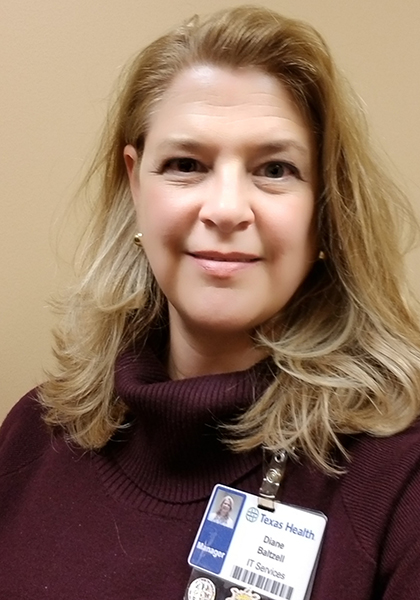

Diane Baltzell, BA, RRT, always loved her career in respiratory care. But when an opportunity arose to move into information technology, this Texas RT decided it was time to expand her horizons and try something new. She explains how it’s worked out.
When and why did you decide to become a respiratory therapist — what drew you to the profession?
After graduating in 1989 with a business administration degree and working in the restaurant industry for a few years, I returned to Wichita State University in 1992. I wanted to work in the medical field and evaluated nursing, medical lab sciences, and respiratory therapy while I took my prerequisite science classes.
I was working as a phlebotomist and decided against lab services early on, and then ruled out nursing after shadowing a friend who worked on a med surg unit. As a phlebotomist, I roamed the hospital and had exposure to respiratory therapists. I liked that they seemed to be everywhere I was instead of tied to one unit. They had lots of variety in their job and it was obvious they were valued and respected at my hospital.
You worked your way up at Texas Health Resources from staff therapist to department director. What fueled your ambition to climb up the ranks and what did you most enjoy about serving as a staff RT and then managing an RT department?
I started with Texas Health Resources (THR) in 2000 at the Presbyterian Plano hospital as a PRN night shift therapist. At that point I didn’t have a career path in mind; I just wanted to get back to work after staying home with small children since our move!
My favorite assignments were always in the ED and ICU. I loved the challenge of the critically ill patients, the pace, the trust placed in me by the physicians, and especially the camaraderie of the night shift staff across all units. Night shifts are never dull in a busy hospital; there is always something new to experience and learn.
At the time, THR was a member of the Collaborative Practice Model Consortium. Each unit had a Practice Council and there was also a larger Hospital Council. I became involved in our department council and eventually became chair of the Hospital Council. These leadership positions provided a different view of working in a hospital and focused on the hundreds of things that affect a patient, from registration to discharge.
After eight years at Plano, I transferred to the smaller Allen hospital to be closer to home. This was a shock — I’d never worked in a small hospital and discovered very quickly what the expression ‘wearing many hats’ really meant! After a year the department manager moved on and I was appointed the interim manager and eventually became the permanent manager, then the department director. One of the surprises of a small hospital was the scope of the departments I was responsible for. In addition to respiratory therapy, my departments included rehab services (PT/OT/speech), EKG and Echo, EEG, and the sleep lab.
As a department manager, I really enjoyed being able to influence how the rest of the hospital perceived respiratory therapists and being able to share with other leaders just what our profession is able to do. One key win was establishing core staffing levels in the department that kept therapists from working without backup.
You recently transitioned to the information technology services (ITS) department at your hospital — tell us a little about that department and what it is responsible for.
THR is a system with 14 acute care hospitals and dozens of facilities, so the scope of IT services is very broad across the company. Each hospital has a local IT department that takes care of functional items such as field services, television service, nurse call, staff communications, at the elbow training and support, radiology PACs, and various projects that need an IT resource to assist with equipment, networking, and interfaces.
Many of our EHR applications are linked to hospital-based technology; examples are assigned patient education modules that show on the television menu and selected alarms sounding directly on the clinician’s communication badge. Our department currently supports two acute care hospitals and three smaller wellness center facilities; we will open a third hospital later this year. Staff are based at one of the hospitals and travel to other locations as needed.
Your new position is manager, ITS Entity Client Services. Why did you decide to apply for that job, and what qualifications did you have to meet to get it?
After eight years as a department leader, I was ready to try something new, but I wanted to stay in my company. I had always looked for ways to be involved in the tech side of health care, so when I found out about this position and that it did not require a specific IT degree I decided to apply. My degree in business and background as a department director fit the posted requirements, and I was able to show the hiring director that I had the skills to be successful in the role. A key factor was my ongoing involvement in hospital and system committees related to electronic health record development and testing, and participation in several pilot projects over the years.
What does the position entail?
I still manage people and projects, just from a different perspective. My role as a department IT manager includes normal administrative work and keeping up with whatever my staff needs to be successful. We have four field service technicians, four EHR training and support personnel, two imaging/PACs admins, one women’s/children admin, and five analysts who support communications, construction projects, AV/paging/nurse call, bed control, and charge analysis. In addition, I manage various small local IT projects, help department managers with technology assessments, escalate problems within the IT structure, work with vendors, and sit on various hospital committees.
What are the top challenges and the top rewards of working in this position and why?
The top challenges certainly lie in the abundance of things that can and do go wrong with the systems we support. Power outages, utility shutdowns, equipment failure, and updates that don’t perform as expected are just a few of them.
The top rewards are definitely when we can help improve someone’s job and the care they provide. It’s a great feeling to know we’ve made a process better, helped implement new solutions for patient safety or installed technology that automates a process or helped someone overcome problems with the EHR. We keep staff and patient safety at the heart of everything we do, from making sure computer cables are neatly organized and out of the way under a desk to helping our EVS staff use a mobile device to track rooms that need to be cleaned.
How does your background in respiratory care help you in your new position?
My background in respiratory therapy taught me critical thinking and situational awareness, and I have intimate knowledge of issues facing clinical staff. I use these skills every day as we troubleshoot problems and look for ways to help our clinicians leverage technology to provide better, more efficient care for their patients. One of our system focus points is to look for ways to automate processes to allow clinicians more time at the bedside. Interdisciplinary teamwork and a focus on how everything impacts patients are two things that are as important to this job as they were to my respiratory therapy job.
What advice do you have for other RTs who might one day like to make the leap from respiratory care to a job in information technology like the one you have today?
Take an interest in the technology used in your department. Learn your electronic health record inside and out and become a resource for others; be a superuser and a preceptor. Volunteer for projects and committees within your department and hospital, and perform well as a member. Look for problems that need to be solved and try to figure out how to solve them with systems you already have. Never, ever, ever mistreat the people working on the help desk!





